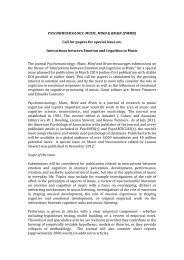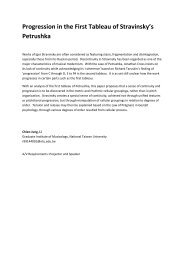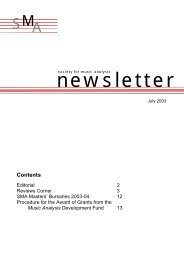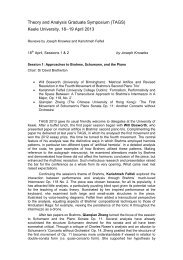Newsletter No. 31 (January 2009) (PDF) - Society for Music Analysis
Newsletter No. 31 (January 2009) (PDF) - Society for Music Analysis
Newsletter No. 31 (January 2009) (PDF) - Society for Music Analysis
You also want an ePaper? Increase the reach of your titles
YUMPU automatically turns print PDFs into web optimized ePapers that Google loves.
Schoenberg, could be thought of ashaving a common purpose. Whendiscussing Debussy‟s late sonatas in anessay from 1959, revised in 1994, Cartergives little or no consideration of mattersof harmony and modality. 8 The kind ofsymmetries and centric possibilities thatremained so stimulating <strong>for</strong> Messiaen areset aside in favour of the kind of <strong>for</strong>malflexibility and unpredictability that becameso important <strong>for</strong> Boulez at much the sametime.Well be<strong>for</strong>e the Debussy essay, in 1953,Carter had written revealingly about hisef<strong>for</strong>ts to extent the scope of „my musicalflow‟, and contended – again in the kind ofterms that Boulez would have endorsed –that the most important features of SecondViennese composers were not twelve-toneroutines but those qualities that had beenestablished in their earlier, expressionistworks: „the high degree of concentration,lending itself to rapid change and thequick, intense making of points. The use ofequally intense melodic shapes, oftenbroken up into short, dramatic fragments,joins with a very varied rubato rhythmictechnique to produce a new kind of whatmight be called instrumental recitative.The rapid increases and decreases ofharmonic tension, quick changes ofregister, and fragmented, non-imitativecounterpoint are also worthy of note. Thisall adds up to a style of remarkable fluiditythat seems to have been derived from thelate works of Debussy but seen throughthe expressive extremes that characteriselate Romantic German music, particularlyMahler and Richard Strauss‟. 9This „remarkable fluidity‟ remained abeacon <strong>for</strong> Carter throughout his career,the consequences of combiningDebussian and Mahlerian qualitiesespecially relevant to such later largescalescores as the Symphonia and theopera What next? For Messiaen, bringingGermanic elements alongside Gallic oneswas always a much more difficult exercise,and his music is never more remarkablethan when managing to evoke Wagnerian,Tristanesque ecstasies without a trace ofthe Wagner – or Mahler, or Berg - style.There might even be some truth in therisky generalisation that it is Stravinsky(after Debussy) who is the most crucialhigh modernist source <strong>for</strong> Messiaen, just8 Carter, Collected Essays, 122–33.9 Carter, Collected Essays, 207.as it is Schoenberg (after Debussy) <strong>for</strong>Carter. When Carter writes revealingly ofthe avoidance of „redundancy‟ as one ofthe central lessons he learned from NadiaBoulanger, 10 it is tempting to link this pointto the comments of Messiaen‟sbiographers about his „uneasy‟ relationswith someone who was „unconvinced byMessiaen‟s music and was not afraid tosay so‟. 11John Link‟s Cardiff presentation was ofparticular interest in using examples fromthe later music to define a style that seemsto float between degrees of stability andinstability, variance and invariance, andprocedures in which (a hint ofconvergence with Messiaen?) pitchrecurrences or emphases mightoccasionally create suggestions ofextended or suspended tonality – or evenof pantonality, in Richard Kurth‟s intriguingreshaping of the Schoenbergiancategories. 12 The tiny, 7-bar „UnaColumba‟ from Tempo e tempi discussedby Link is especially suggestive in thisrespect, and the wider sense of a humanevision of life, and of the world floatingbubble-like in space as something torejoice in rather than to merit fearfullamentation, rein<strong>for</strong>ces Carter‟s distinctivemodernism and also strongly countersTaruskinian arguments that his work iswithout social concerns. Just as Messiaenhymns the spiritual life, so Cartercelebrates humanist stoicism, showinghow much sheer joy can emerge from thecontemplation of infinite space. It may bejoy tinged with irony and regret, but it is joynone the less. The dense, stratifiedinvariants shown by John Link at the endof Partita have their complement in thedissolving ascent at the end ofSymphonia‟s finale, Allegro scorrevole, inCarter‟s version of that „light from thebeyond‟ of which Messiaen‟s last largescaleorchestral work, Eclairs sur l’au-delàoffered a Christian version. The continuingchallenge to analysts is to illuminate thislight-charged music with a vision andseriousness appropriate to its characterand stature.Arnold Whittall10 Carter, Collected Essays, 284.11 See <strong>No</strong>te 4.12 Richard Kurth, „Moments of Closure: Thoughts onthe Suspension of Tonality in Schoenberg‟s FourthQuartet and Trio‟, in <strong>Music</strong> of my Future. The StringQuartets and Trio, ed. R. Brinkmann and C. Wolff(Cambridge, MA: Harvard University Press, 2000),139–60.SMA newsletter 8







